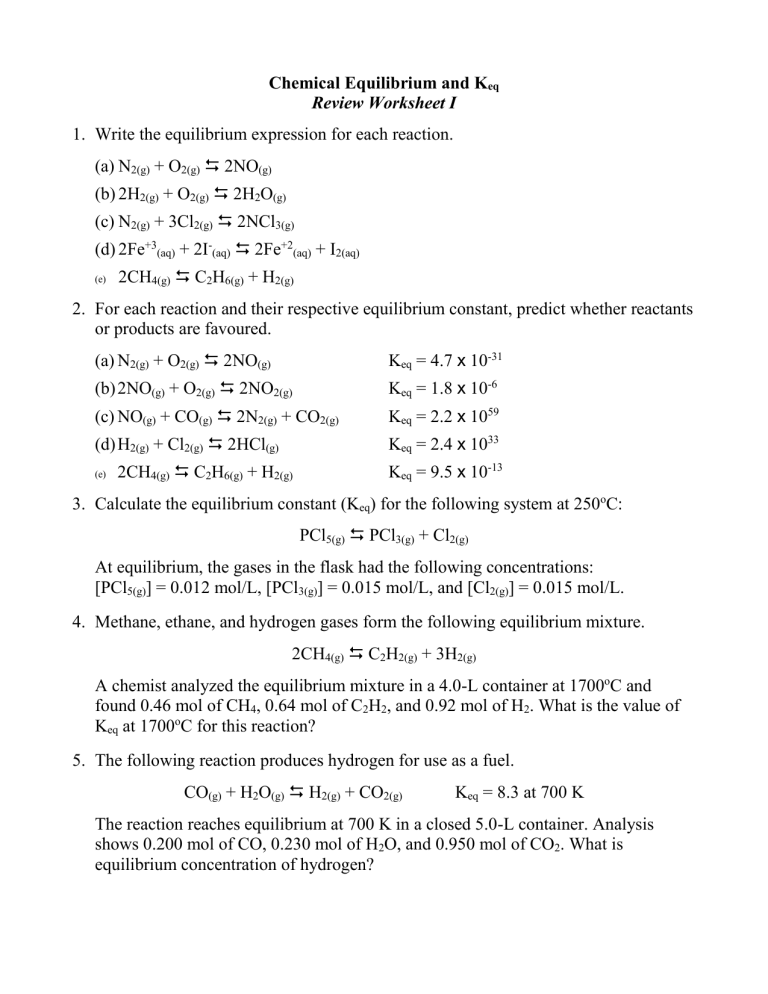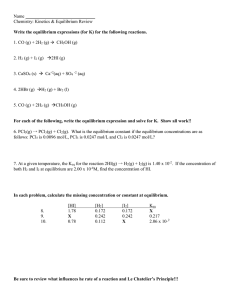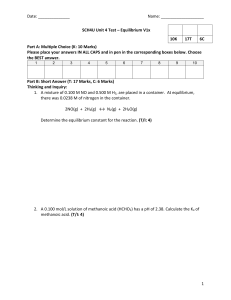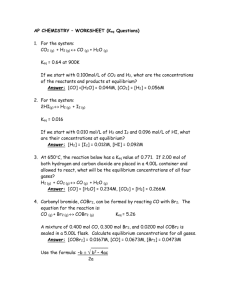
Chemical Equilibrium and Keq Review Worksheet I 1. Write the equilibrium expression for each reaction. (a) N2(g) + O2(g) 2NO(g) (b) 2H2(g) + O2(g) 2H2O(g) (c) N2(g) + 3Cl2(g) 2NCl3(g) (d) 2Fe+3(aq) + 2I-(aq) 2Fe+2(aq) + I2(aq) (e) 2CH4(g) C2H6(g) + H2(g) 2. For each reaction and their respective equilibrium constant, predict whether reactants or products are favoured. (a) N2(g) + O2(g) 2NO(g) Keq = 4.7 x 10-31 (b) 2NO(g) + O2(g) 2NO2(g) Keq = 1.8 x 10-6 (c) NO(g) + CO(g) 2N2(g) + CO2(g) Keq = 2.2 x 1059 (d) H2(g) + Cl2(g) 2HCl(g) Keq = 2.4 x 1033 (e) 2CH4(g) C2H6(g) + H2(g) Keq = 9.5 x 10-13 3. Calculate the equilibrium constant (Keq) for the following system at 250oC: PCl5(g) PCl3(g) + Cl2(g) At equilibrium, the gases in the flask had the following concentrations: [PCl5(g)] = 0.012 mol/L, [PCl3(g)] = 0.015 mol/L, and [Cl2(g)] = 0.015 mol/L. 4. Methane, ethane, and hydrogen gases form the following equilibrium mixture. 2CH4(g) C2H2(g) + 3H2(g) A chemist analyzed the equilibrium mixture in a 4.0-L container at 1700oC and found 0.46 mol of CH4, 0.64 mol of C2H2, and 0.92 mol of H2. What is the value of Keq at 1700oC for this reaction? 5. The following reaction produces hydrogen for use as a fuel. CO(g) + H2O(g) H2(g) + CO2(g) Keq = 8.3 at 700 K The reaction reaches equilibrium at 700 K in a closed 5.0-L container. Analysis shows 0.200 mol of CO, 0.230 mol of H2O, and 0.950 mol of CO2. What is equilibrium concentration of hydrogen? 6. At 300 K, 0.045 mol of hydrogen and flourine are placed in a closed 1.0-L container and allowed to reach equilibrium. H2(g) + F2(g) 2HF(g) Keq = 4.3 at 300 K What is the equilibrium concentration of HF(g)? 7. The following reaction has reached equilibrium at 1100 K. H2(g) + I2(g) 2HI(g) Keq = 25.0 at 1100 K If 2.00 mol of H2(g) and I2(g) were initially placed in a 1.00-L reaction vessel, what is the equilibrium concentration of each gas? 8. At 100oC, 1.50 mol/L of phosgene gas (COCl2) is decomposing in a closed container based on the following chemical equation. COCl2(g) CO(g) + Cl2(g) Keq = 2.2 x 10-31 at 300 K What is the equilibrium concentrations of CO(g) and Cl2(g)? 9. At a certain temperature, the equilibrium constant for the reaction between sulfur dioxide and nitrogen dioxide is 4.8. SO2(g) + NO2(g) NO(g) + SO3(g) The initial concentrations of SO2(g) and NO2(g) were 0.36 mol/L. How many moles of SO3(g) will be produced if the reaction occurs in a 5.00-L closed reaction vessel? 10.Hydrogen gas has several advantages and disadvantages as a potential fuel. Hydrogen can be obtained through the thermal decomposition of water. 2H2O(g) 2H2(g) Keq = 7.3 x 10-18 at 1000oC + O2(g) (a) The initial concentration of water vapour in a reaction vessel is 0.055 mol/L. What is the equilibrium concentration of H2(g) at 1000oC? (b) Comment on the practicality of the thermal decomposition of water to obtain hydrogen as a fuel. 11.In a container, carbon monoxide and water vapour are producing carbon dioxide and hydrogen at 900oC. CO(g) + H2O(g) H2(g) + CO2(g) Keq = 4.00 at 900oC If the concentrations at one point in the reaction are: [CO(g)] = 4.00 mol/L, [H2O(g)] = 2.00 mol/L, [CO2(g)] = 4.00 mol/L, and [H2(g)] = 2.00 mol/L. Determine whether the reaction has reached equilibrium, and, if not, in which direction it will proceed to establish equilibrium.





